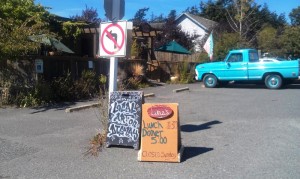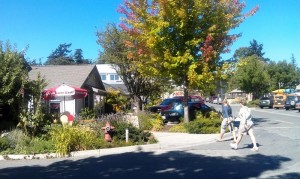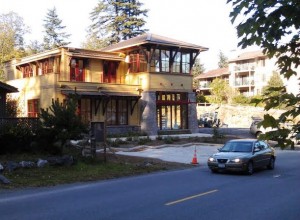
This corner on Prune Alley could use some "bulb-out" curbing that may be included in the Streetscape plan
Committee also considers Ocean Forest project on Main Street
Eastsound Planning and Review Committee considered options and costs of the revised Streetscape Plan during its Sept. 1 meeting.
The first hour was taken up conferring with County Engineer Rachel Dietzman on the Streetscape Plan, dealing with on-street parking in Eastsound village. Parts of the plan that were peripheral to their Sept. 1 discussion were transportation shuttle stops, motorcycle and bike parking, pedestrian trails and small-scale stormwater treatment.
The final vision will be refined in a public process and adopted as part of the Eastsound Subarea Plan.
EPRC members Bob Connell, Fred Klein and Teri Williams reviewed the most recent aerial Streetscape plans with Dietzman (who replaced John Van Lund in supervising this project last November).
Gravel sidewalks, rather than concrete, were considered; Dietzman described using a smaller-sized gravel particle which would compact more readily, and cause less shifting than gravel.

Radius curbs or "bulb-outs" at the intersection of "A" Street and North Beach Road
The question of who pays for the solutions – the County or Eastsound business owners revived the polite and often unproductive tug-of-war between the EPRC as a county advisory committee and county staff, employed to carry out the directions of the County Administrator, under the guidance of the County Council.
Dietzman said that, beyond completion of Eastsound’s Streetscape Plan, Orcas Island has “some very important needs for its roads,” citing Nordstrom Lane, Olga Road, Crow Valley Road and two locations on the Deer Harbor Road. (Currently the County is repairing the road between Olga and Doe Bay).
Dietzman suggested that a cooperative Local Improvement District (LID) may be a solution. County Council Member for Orcas East Patty Miller said that, while she was not opposed to LIDs as a solution, “As county officials, we have demands of UGA [Urban Growth Area in Eastsound]. There are more expensive needs in UGAs.”
Miller pointed out that while the county just got grant funding to update the transportation element of its Comprehensive Plan, “there is very little focus on the Eastsound Sub-area.”
Dietzman advised that the Eastsound streets are to be resurfaced (chip-sealed) within three years, and no further improvements would be undertaken for an additional three years. She suggested that the EPRC frame the improvements to include what could be accomplished with the funds available in the next three years.
Dietzman said, “If there’s a plan for doing something more, a partnership or an LID, maybe we’ll wait and do it in six years… but if we wait six years, we may have to come in and do spot repairs that we wouldn’t have to do in three years.”
The discussion involved parallel and angled parking, which would involve obtaining easements from property owners.
As the EPRC considered the most necessary improvements to the Streetscape Plan, Fred Klein described the task before them as considering “a viable concept that is not putting money down the drain, or putting band-aids on the situation.
“If we can’t do continuous curbs, let’s take care of the intersections [of Prune Alley and Fern street, “A” Street, and Rose Street.]”
Those corners on Prune Alley could be improved by the implementation of “bulb-outs”or radius curbs such as currently exist at North Beach Road and “A” Street, and Dietzman agreed that there may be funding through the Scenic Byways program to complete both the chip sealing and the radial pedestrian crossing.
Dietzman asked what kind of process the EPRC would take in advancing the Streetscape Plan. She said that the County Public Works Department is “strapped for funds as well as personnel. We’re looking for help, we’re looking for people who would like to shepherd projects or partner with us.
“We don’t want to have a controversial project that will get thwarted at the end; we want to have buy-in in the project.”
She suggested returning to the EPRC in a month or two after they had discussed the Streetscape Plan further.
Miller, who was formerly an EPRC member, said, “It would be great to see Prune Alley finished. I would like to see the EPRC make a proposal that we could give [Dietzman] and she could make a map and start the public participation process.”
County Council Member for Orcas West, Richard Fralick advised, “You have a three-year horizon to give you something to focus on. To make a decision and make something concrete happen would be very positive.”
Fred Klein will take the plan and make draft revisions. Teri Williams encouraged the group to look at the planting requirements with an eye towards saving water.

Car advances in front of angled parking at issue in the development of Ocean Forest
Comments from Bill Trogden of the Eastsound Design Review Committee (EDRC) were scheduled to address the development of the “Ocean Forest” property and buildings on Main Street. In Trogden’s absence, the EPRC reviewed the process by which Ocean Forest developer Shawn DeMeritt had been permitted, the EPRC’s limitations as an advisory committee, and whether their advised changes to the project’s parking had been implemented.
(In 2007, DeMeritt had come to the EPRC with a draft of his plans for 12 to 16 new homes between the Washington Federal Bank and the Landmark Inn properties on Main Street. The conceptual presentation raised some concerns, but the land use and permit applications were not sent to the EPRC for review)
Miller said that projects such as Ocean Forest need to get better scrutiny early in the permitting process. The County permitting offices could make good use of the EPRC as a resource in its initial review, she suggested.
Fralick urged the EPRC to finalize a process checklist that’s “personnel-independent” of both the EPRC and the County. The importance of including a timeline in the checklist, so that the EPRC may review applications and permits earlier in the process was also emphasized.
Terri Williams has been developing such a checklist with County Planner Chris Laws, and will continue to finalize it.
The Eastsound Planning Review Committee (EPRC) was established in 1981 under the authority of the Eastsound Subarea Plan by the San Juan County Commissioners. It consists of seven Orcas Island residents, appointed by Commission [now Council] to advise the planning department, the planning commission and the County Council on land use and development matters affecting Eastsound.
**If you are reading theOrcasonian for free, thank your fellow islanders. If you would like to support theOrcasonian CLICK HERE to set your modestly-priced, voluntary subscription. Otherwise, no worries; we’re happy to share with you.**








Bicycle trails need to be considered in any long-term plan as well as bike parking. Why is there no mention of trails?
Bruce Buchanan
Bicycle trails and paths are a MUST consideration. Orcas pretends that it is bicycle friendly and that bicycling is a recreation option for visitors. Residents know better – – Orcas is bicycling unfriendly. I would never have my adult children, much less my grandchildren, bicycle on Orcas except in very limited areas.
Lets start dealing with this matter in Eastsound, then expand the solutions to other parts of the island.
Ah, yes, another taxing district–that’s the ticket! I don’t recall Eastsound begging to be designated a Urban Growth Area by the County–the result is a huge burden on the village–our planners have said that Eastsound UGA will have to “absorb” one-half of all future population growth! That’s 1100 people and 500 houses, all in the UGA.